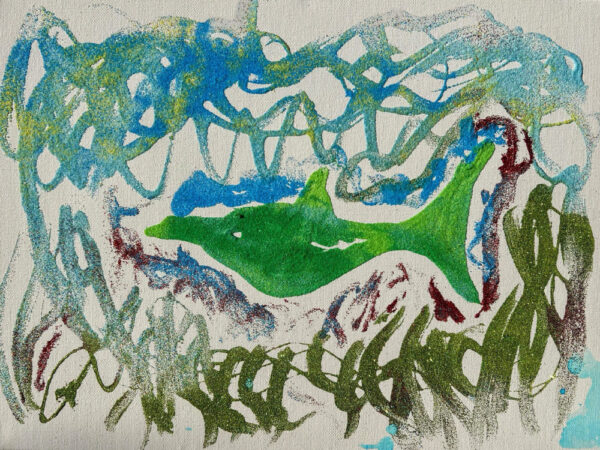By Alex Tibbitts
Five-year-old Westsider Inara Wilson stole the show as the youngest of 10 winners in the National Fantastical Shark & Rays children’s art competition. Her artwork is now showing at the Australian Museum in Sydney, alongside pieces by famed Australian artists, including Ken Done and 2022 Archibald Prize winner Blak Douglas.
To raise awareness and help protect Australia’s lesser-known and endangered sharks and rays, The Australian Marine Conservation Society (AMCS) and Humane Society International Australia ran a competition. They asked budding da Vincis to create an artwork depicting one of the ten endangered shark and ray species, and received more than 1500 entries from all over Australia.
Ten Australian artists, including Done and Douglas, were then asked to create works inspired by the ten winning children’s entries
Not a lot is known about these creatures, so the children were given a written description of the animals to spark their imaginations. Inara was inspired by the description of the swellshark: ‘Take a deep breath! When this swellshark feels threatened, it swallows water to make itself look bigger and harder to eat. It lays eggs called a ‘Mermaid’s Purse’, but it has to watch out for fishing hooks or trawler nets that could scoop it up from its home on the bottom of the sea.’

“We chose the whitefin swellshark because the name and description of a swelled shark conjured up an instant image in Inara’s imagination,” says Inara’s mother Muriel Aldunate. “She layered glue on canvas and used different coloured sands to create the swellshark’s environment and its comical rounded belly. Her sister and her had such fun learning more about the wonderful sharks, rays and skates of Australia.”
Sydney installation artist Jennifer Turpin says she chose Inara’s artwork for her inspiration because she painted the swellshark surrounded by sand and seaweed, which showed her understanding of the importance of the shark’s home.
“Sharks and rays are the sentinels of this blue expanse, and our own existence depends on theirs,” Turpin says. “The vast unfathomable ocean is a constant source of inspiration and wonder, its rhythmic ebb and flow resonate with my artistic spirit.”
Australia is home to one quarter of the world’s sharks and rays species, with more than 300 species in our waters. Nearly half are endemic – found nowhere else in the world – and 13 of our endemic sharks are threatened with extinction mostly due to overfishing. Many are caught accidentally as ‘bycatch,’ and sometimes their meat is sold at fish and chip shops.
AMCS shark expert Dr Leonardo Guida says the swellshark is critically endangered but it’s legal to catch them and sell their meat. “It risks ending up in our fish and chip shops, commonly sold as flake,” he says.
“This simple idea has resonated with more than 1500 school children from across Australia, who in the process have come to learn about our lesser-known sharks and rays, which we are at risk of losing,” says Professor Kris Helgen, Director and Chief Scientist of The Australian Museum Research Institute.
The 10 winning children’s artworks were reimagined by the artists Ken Done, Blak Douglas, Sarah & Sebastian, Jennifer Turpin, Billy Bain, Janet Laurence, Dion Horstmans, Rosie Deacon, Dylan Mooney and Jonathan Zawada.
The children’s and artists’ work will be displayed alongside each other at the museum’s Fantastical Sharks & Rays exhibition until December 8.

